What activities are okay? What are the total knee replacement precautions you need to know about?
Stuart C. Kozinn MD / Scottsdale Joint Center
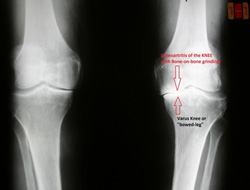
So now you have been told the only way to get rid of your burning, grinding, bone-on-bone knee pain is a “Knee Replacement” – a new knee. This is now one of the most common orthopedic operations in the USA. Over a half million knees are done every year. What are the total knee replacement precautions you need to worry about after surgery? Osteoarthritis of the knee is rising at an “epidemic” rate, just as patients are demanding a more active life style. Now younger patients in their forties and fifties are much more common total knee candidates. Total knee patients can do a number of sports. I allow my partial knees to do a bit more spors than my total knees. The partial knees still have normal cruciate ligaments which greatly help stabilize the joint during sports. They can run at a steady pace, such as in distance running – 10K for instance. I would rather they do not sprint however, as the implant may be more at risk over time from hard pounding.
But what can you actually do with your Total Knee?, and more important what activities CANT you do?. In a perfect world without liability for implant failures, we might let total knee patients do “anything they wanted to”. However, we have to “over treat” by being extra cautions in everybody with a total knee, because we don’t know which particular knee may be more susceptible to loosening. Each person has a unique biological reaction to foreign implants and to wear debris and stress. Bone quality can be vastly different in different people. Some patients might be able to safely do more things. For instance, A thin very fit woman would likely do better playing singles tennis then an overweight out of shape man.
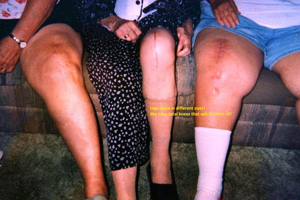
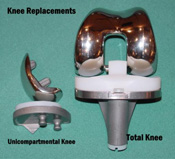 In fact, some of my patients choose to run, play basketball and racquetball against my general medical advice. In my 25 year personal experience the vast majority of these “non-compliant” (spirited/adventurous?) patients actually do very well, …much better than expected! Unlike hips, total knees do not easily “dislocate”, or come out of joint. So we are less concerned about that happening in the middle of a strenuous activity. However, we know that total knees do NOT last forever. They are little machines that will take care of you longer , if you take care of them!
In fact, some of my patients choose to run, play basketball and racquetball against my general medical advice. In my 25 year personal experience the vast majority of these “non-compliant” (spirited/adventurous?) patients actually do very well, …much better than expected! Unlike hips, total knees do not easily “dislocate”, or come out of joint. So we are less concerned about that happening in the middle of a strenuous activity. However, we know that total knees do NOT last forever. They are little machines that will take care of you longer , if you take care of them!
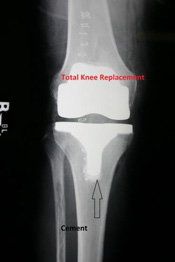 How do total knees gradually fail? For starters, they are CEMENTED into the bone. And just like cracks form in the sidewalk over years after extremes of weather, cracks can occur in cement inside your knee. This is more likely if you “beat your knee up” on a regular basis. This is why we do not recommend running for daily exercise after a knee replacement. The constant repetitive “jarring” could lead to cement cracks and eventual loosening of the implant. I do let my patients play tennis (doubles is safer), ski, wakeboard, play golf, bike ride, swim, and do similar sports. Bike riding, Yoga and swimming are the best exercises. After 25 years of doing total knees, a very small percentage of my knees have failed. Some have required revision surgery ( Re-do). Fortunately, re-dos actually perform quite well. Years ago I took care of a professional baseball player with a total hip. He wanted to play again. he knew the risk, but his major question was, If my hip fails, can you re-do it?” With a yes answer, he was comfortable playing, and I watched him jog around the bases flawlessly after hitting a home run.
How do total knees gradually fail? For starters, they are CEMENTED into the bone. And just like cracks form in the sidewalk over years after extremes of weather, cracks can occur in cement inside your knee. This is more likely if you “beat your knee up” on a regular basis. This is why we do not recommend running for daily exercise after a knee replacement. The constant repetitive “jarring” could lead to cement cracks and eventual loosening of the implant. I do let my patients play tennis (doubles is safer), ski, wakeboard, play golf, bike ride, swim, and do similar sports. Bike riding, Yoga and swimming are the best exercises. After 25 years of doing total knees, a very small percentage of my knees have failed. Some have required revision surgery ( Re-do). Fortunately, re-dos actually perform quite well. Years ago I took care of a professional baseball player with a total hip. He wanted to play again. he knew the risk, but his major question was, If my hip fails, can you re-do it?” With a yes answer, he was comfortable playing, and I watched him jog around the bases flawlessly after hitting a home run.
Some knee failures occur after the plastic bearing (or cushion) between the metal parts has worn down over many years. The plastic particles can have an inflammatory effect on the knee, causing swelling, and some bone loss. That is why we are always searching for a better, more durable plastic. the cross linked polyethylene plastic liners we use now ARE more durable than the ones used 20 years ago. So we don’t really know how long they will last. Lab simulation wear testing suggests the plastic can last out thirty years or so. I now tell patients that 80 percent of my total knees will still be functioning well twenty years out, I just don’t know which 20 percent will have some problems. Interestingly enough, so far in general it has NOT been the more athletic patients that fail sooner. I have seen more failures in overweight women with soft bone. After menopause, some women develop osteoporosis, and I have seen failures where their own weight causes the implant to “crush into” the bone, causing pain and loosening. My patients should all take calcium and vitamin supplements to keep the bone strong!
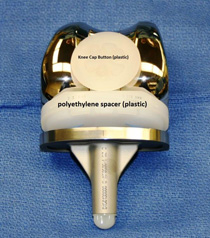
So what activities are OK?
-
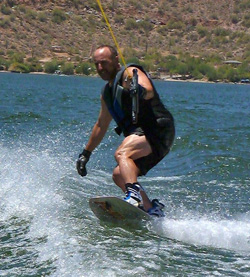
Dr. Kozinn showing decent form on the wakeboard – He does not have a total knee (yet!), but wakeboarding and skiing is ok with a total knee. Tennis ( doubles is always better, but I allow singles for those that really want to play)
- Golf (use a cart if you get fatigued or your leg tends to swell after a full day up and about – wear your ted hose under your pants)
- Bike Riding – any type (Don’t crash or fall!)
- Swimming ( best overall exercise for joint replacements, but the hardest to do regularly – also a little boring)
- Hiking ( be reasonable – don’t do Camelback to the top with a total knee, but you can go up to the heliport)
- Skiing ( snow and water ok – snow skiing is more dangerous in general as you add velocity to torque – watch out for the other guy on a snow-board. Ski at your own risk!)
- Skating – ice hockey is ok if you eliminate the body checks!
- Gym / machine work outs ( don’t do a lot of full weight squats, as it puts increased pressure on the knee caps).
- Aerobics ( it depends – less jumping is better)
- Yoga – great for everything
- Softball – seems to be OK, unless you play like Derek Jeter ( then goes to “no” list below!)

What activities are NOT always ok?
- Hard Running ( you do it at your own risk – it is possible to run – jogging is better then a full out sprint- but it is risky, and it may take years , but eventually it may damage the cement bond of your knee.)
- Football- you should avoid running in a football game. You can play catch with a football though!
- Soccer – you can kick the ball with your kids, but you should avoid running hard in the games. OK to play goalie.
- Volleyball – with jumping – unless you just stand in your position and pass the ball! ( same as above)
- Basketball – I have patients who do play basketball with total joints, we just can’t recommend it because we don’t know if the jumping will eventually damage the cement bond with the bone.
- Racquetball ( a little rougher on the knee-caps than tennis due to increased and more frequent bending- I do have patients who choose to play and seem to do OK)
So, everyone is an individual, and we all make our own risk vs. benefit decisions. If not playing a sport will make you “depressed, lazy, and fat”, then maybe taking the risk of earlier loosening is worth it to you. After all…”the knee replacement can be re-done”.
PS: Boxing is OK!
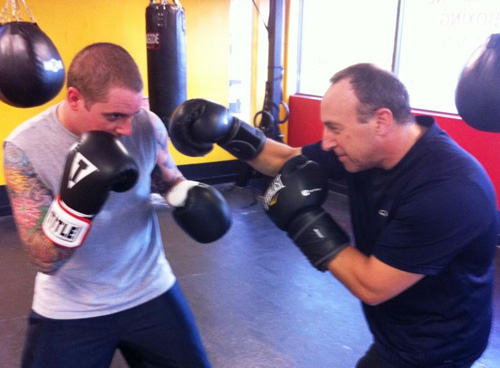
Please come in to talk about your specific needs.
– Stuart Kozinn MD
Medical Director Total Joint Center – Scottsdale Healthcare.